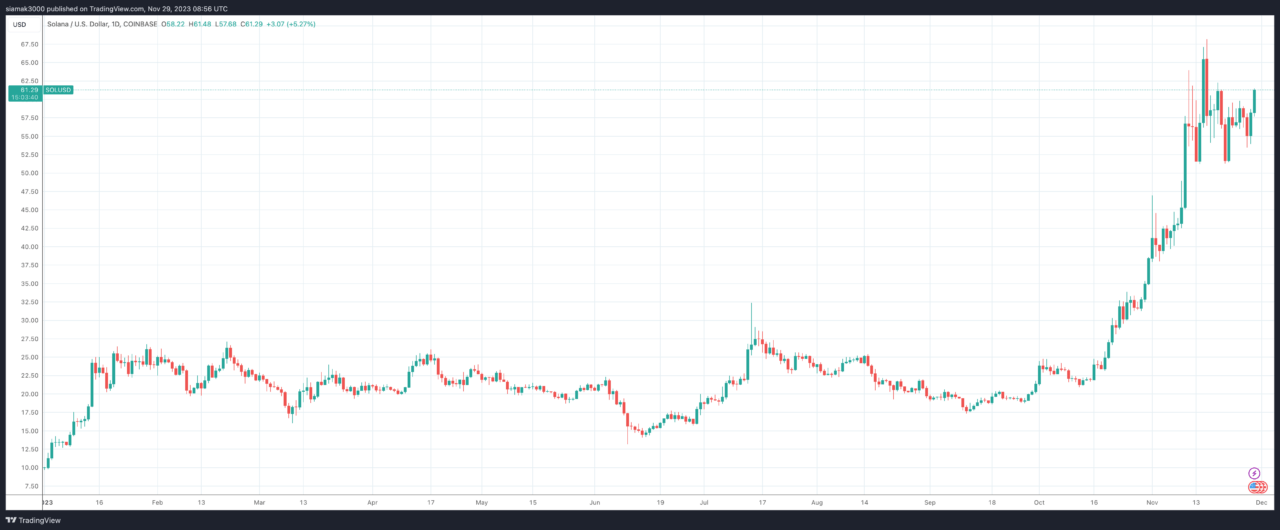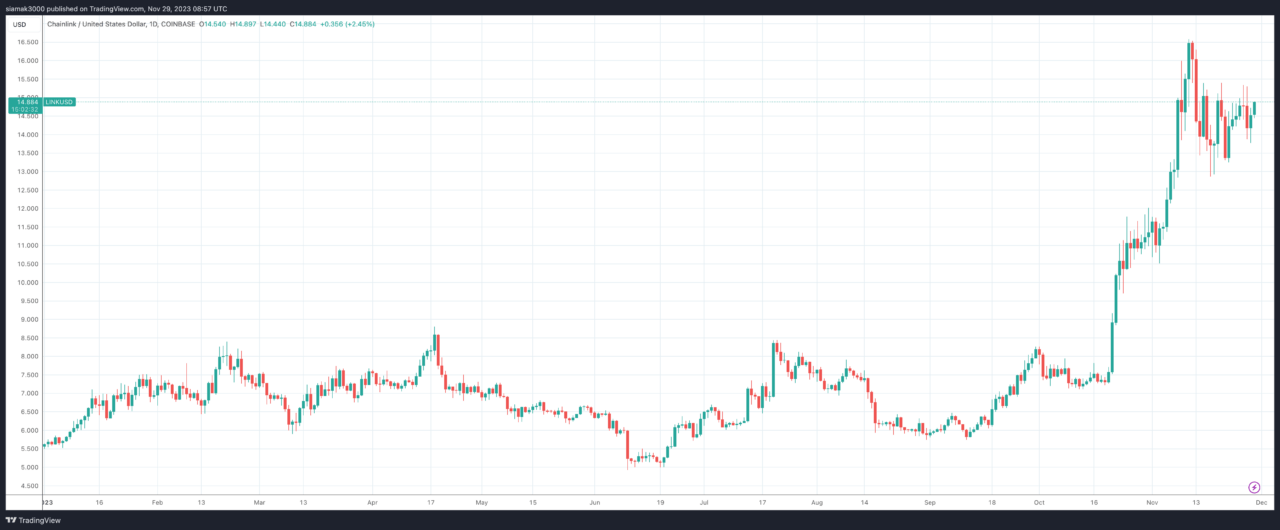A prominent crypto analyst, known as The Flow Horse, has recently shared his optimistic outlook on two altcoins, Chainlink (LINK) and Solana (SOL), as Bitcoin (BTC) reclaims its position in the $38,000 range. The analyst, who has garnered a following of 188,000 on social media platform X, believes these two cryptocurrencies exhibit significant upside potential.
The Flow Horse identifies Chainlink and Solana as consistent leaders in the current market movement. He is particularly bullish on these projects due to their distinct characteristics. Chainlink and Solana, often touted as competitors to Ethereum, are seen as strong contenders in the crypto space.
At the time of writing, $SOL is trading at around $61.34, up 8.85% in the past 24-hour period (up 497.43% in the year-to-date period).
As for $LINK, it is trading at around $14.894, up 5.59% in the past 24-hour period (up 161.39% in the year-to-date period).
The analyst also extends his bullish sentiment to projects associated with artificial intelligence and new coins with low available floats. He highlights the advantage of these coins not having a “psychologically burdensome bearish price history and bag holder overhang,” which can often deter investors.
In addition to his views on specific cryptocurrencies, The Flow Horse comments on the broader market dynamics. The crypto analyst highlights the current volatility in the market, noting that many traders are facing losses (“getting chopped up”).
Here is his perspective:
- Market Behavior Pre-ETF Decision: He observes that major investors aren’t selling their holdings before the upcoming decision on a Bitcoin ETF. The market fluctuations we’re seeing are due to smaller, short-term trading strategies, like minor leverage washouts (where leveraged positions are closed out) and spot dumps (selling assets quickly). These are quickly reversed as the sold assets are promptly repurchased.
- Opportunity in Market Fluctuations: If there’s a significant drop in prices (“a flush”) before the ETF decision, it might be a good time to step away from active trading. This is because such a drop is likely to be temporary, and prices might rebound quickly, potentially leading to missed opportunities for those not paying attention.
- Chicago Mercantile Exchange (CME) Position: The CME is heavily invested in long positions (“long to the gills”), but the cost of maintaining these positions is rising. This is due to the increasing expense of rolling up the futures curve, a strategy involving selling futures contracts at lower prices and buying at higher prices over time.
- Post-ETF Decision Market Movement: He predicts that the market will likely experience a surge once the ETF news is released. Following this surge, traditional finance (TradFi) players are expected to start taking profits, particularly from late retail investors who join the momentum later.
- Trading Strategy Advice: The analyst suggests that this scenario presents a clear opportunity for spot trading. For those considering short-selling (betting that prices will fall), he advises keeping such strategies tactical and well-planned, given the expected market movements.
Since his appointment to the Board of Governors of the Federal Reserve System on 18 December 2020, Christopher J. Waller has played a crucial role in shaping the direction and policies of the Federal Reserve. Speaking yesterday at the American Enterprise Institute in Washington, D.C., Waller presented a measured yet hopeful perspective on the state of the U.S. economy and the ongoing issue of inflation. He revisited themes from his earlier speech, “Something’s Got to Give,” where he contrasted robust economic growth and strong employment figures against a slowing in core personal consumption expenditures (PCE) inflation.
Waller pointed out the need for the economy to slow down from its vigorous growth in the third quarter. This deceleration is crucial to meet the Federal Open Market Committee’s (FOMC) inflation target of 2 percent. He cited recent data from October, which showed a decrease in consumer spending and lower economic activity projections for the fourth quarter, as signs of this needed slowdown.
Despite these developments, Waller warned that inflation is still excessively high, and it’s too early to declare a definitive economic slowdown. He expressed belief in the effectiveness of current policies to decelerate the economy and bring inflation back to the 2 percent target while also recognizing the unpredictability of future economic trends.
Waller’s comments, which suggested a possible relaxation in stringent monetary policies, seemed to have a favorable impact on financial markets. Remarkably, Bitcoin’s value jumped almost 4%, surpassing $38,000 after his address. This market response highlights the profound influence Federal Reserve policies and announcements have on both conventional and cryptocurrency markets.
Featured Image via Pixabay
Source: Read Full Article


